The main objective is to incorporate culture into the city's policy framework by integrating cultural aspects into education, transportation, inter-city collaborations, environmental management, resident programs, ward initiatives, library networks, public events, and community engagement activities
Published Oct 31, 2024 | 7:00 PM ⚊ Updated Oct 31, 2024 | 8:34 PM

A Jewish devotee performs Shofar, a ritual instrument crafted from a ram's horn, traditionally used in significant Jewish religious and public ceremonies. (Photo: Kerala Tourism)
For the first time in India, a city corporation has unveiled a culture policy that aims at making Kochi more liveable while preserving its unique cultural identity.
This comes even as Queenie Hallegua, among the last of Kochi’s Jewish residents, passed away recently. Her nephew, Keith Hallegua, is now the sole Jew in the city.
There is much that needs careful preservation in Kochi. Thaha Ibrahim, a Muslim in his seventies, still welcomes visitors into Sarah’s Hand Embroidery — the last Jewish embroidery shop here.
In Fort Kochi, the Dutch cemetery bears the graves of settlers who lived and died in Kerala. Mattancherry Palace, built by the Portuguese in 1555 for King Veera Kerala Varma, was renovated by the Dutch in the 17th century, and is now often referred to as the Dutch Palace.
During Kesava Rama Varma’s rule (1565–1601), Jews settled in Kochi, establishing Jew Town and a synagogue. Rama Varma also granted land in Mattancherry to the Konkinis.
In 1609, the British arrived, and in 1663, the Dutch seized Cochin Fort from the Portuguese.
Queen Gangadhara Lakshmi, crowned by the Portuguese, was the only woman ruler of Kochi, and she ascended to the throne in 1656.
Sakthan Thampuran, Rama Varma V, strengthened the kingdom when he ascended in 1790.
Kochi’s heritage, however, extends beyond Fort Kochi and Mattancherry.
It’s a city of diverse beliefs and flavors, with stories in every corner. It is to preserve the uniqueness of the city that the Kochi Corporation introduced a culture policy, with the aim of making the city hospitable for its residents while also preserving history.
The policy document, prepared by the city corporation in collaboration with the Centre for Urban Studies at the School of International Relations and Politics at Mahatma Gandhi University and the Centre for Heritage, Environment, and Development (c-hed), states that the attempt is not to plan to be a “replica” of some other city; “culture is a good way not to fall for replicas, because culture is an embodied concept though connected, fluid and transforming,” the document states.
This policy situates Kochi’s identity not just within Fort Kochi, Mattancherry, or the mainland Ernakulam administration, but extends beyond the 94.88 square kilometers of the city, embracing an urban agglomeration encompassing municipalities and panchayats, each with its distinct socio-ecological background.
The rapidly urbanising zones of Thripunithura, Trikkakara, and Kakkanad; the industrial hubs of Kalamassery and Eloor; the serene backwater areas of Varapuzha and Vypin; the mercantile centers of Mattancherry; the colonial heritage sites of Fort Kochi and Kottayil Kovilakam; the handicraft villages of Chendamangalam; fishing villages like Kadamakkudy and Gothuruth; and riparian towns like Aluva and Kalady are all considered in the policy.
According to a Kochi Municipal Corporation official, “Kochi’s cultural imaginaries have evolved far beyond traditional associations, as seen in projects like the Biennale and Arts Space Kochi. This policy framework aims to integrate these existing expressions and expand to include broader frameworks such as Kerala’s post-2020 cultural initiatives, national efforts, UNESCO guidelines, SDG (Sustainable Development Goals of the UN) frameworks, and global models like the UN’s Agenda 21.”
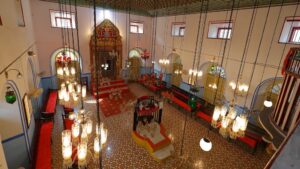
The Kadavumbhagam Synagogue in Mattancherry in Ernakulam district of Kerala was built sometime around 1549.
This policy paper explores the intricate historical and cultural strands that have shaped Kochi. The city’s unique urban genealogies, mercantile histories, community convergence, linguistic diversity, and material traces are all considered, to address the significant overlays and impacts of these on Kochi as a city.
In the late 1990s, older urban zones began to recede, giving way to newer urban developments in Ernakulam and the rapidly expanding satellite towns across Kerala. This transformation meant a shift in the city’s spatial dynamics and urban identity.
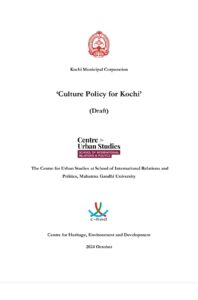
Policy Draft
Recent initiatives, such as proposals for Streaming and OTT platforms for studios and artists, have emerged alongside groundbreaking projects like Arts Space Kochi, initiated by c-hed, and the popular Kochi Biennale. These highlight the city’s commitment to fostering a vibrant cultural landscape.
The primary goal is to embed culture within the city’s policy framework. This involves integrating cultural considerations into educational institutions, transportation networks, inter-city collaborations, environmental management, resident association programmes, ward-level initiatives, library networks, public events, and community engagement activities.
The policy advocates for a place-based perspective of Kochi, emphasising the city’s unique characteristics rather than treating it as a generic urban space. This approach recognises the specific cultural and historical contexts that shape the city’s identity.
Kochi initially gained prominence as a center for the Indian spice trade, attracting traders from as far as Greece, China, and the Middle East. Its strategic geography meant Kochi was a crucial point for trade and cultural exchange between the regions of South Asia, Southeast Asia, the Middle East, and Europe. Before the arrival of colonial powers, Kochi emerged as a thriving port polity.
It was the lucrative spice trade that drew Christopher Columbus to set sail from Europe in 1492. In the 16th century, Portuguese control was established in Kochi. The Portuguese were later replaced by the Dutch in the 17th century and subsequently by the British.
The 20th century brought rapid social and structural changes, particularly following India’s independence. While neighborhoods like Mattancherry and Fort Kochi — once central to colonial Kochi — have become less prominent in the contemporary landscape, their rich cultural and architectural legacies continue to play a vital role in understanding Kochi’s hybrid history.
Historian Sanjay Subrahmanyam notes that the resilience of local communities allowed them to forge connections with European traders, actively engaging in socioeconomic transitions.
After India’s independence, the princely state of Kochi, including Mattancherry and Fort Kochi, integrated into the Indian Union.
M.O. Koshy notes that shifting political priorities led the new state to focus development efforts on emerging urban centers, sidelining former colonial cores.
Hugo S. Jacob highlights that Mattancherry, once a bustling economic center, lost its prominence after independence. Conservation efforts have since aimed to preserve the hybrid cultures of Mattancherry and Fort Kochi, striving to balance historical preservation with ongoing community relevance.
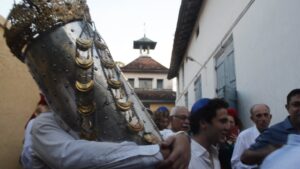
The Reunion Festival celebrated at Mattancherry Syngagoue.
Kochi has seen rapid commercial expansion and urbanisation since the 1990s, driven by India’s liberalisation policies. Its strategic location and natural harbour have boosted sectors like real estate, tourism, IT, and port industries.
However, this modernisation co-exists with a rich architectural legacy, especially in neighborhoods like Mattancherry and Fort Kochi.
The Paravur-Kodungaloor area is linked to the ancient port of Muziris, a vital hub for Greco-Roman trade. Excavations at Muziris reveal extensive trading networks that existed long ago, evidenced by artifacts like amphora jars, Roman coins, Mediterranean glass beads, and reserves of black pepper.
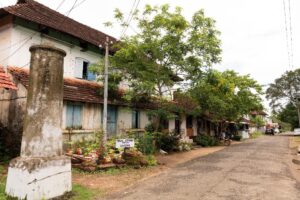
The Jew Street at Paravur is famous for the Paravur market and Paravur Jewish Synagogue.
These findings illustrate not just colonial exploits but dynamic two-way cultural exchanges among societies.
By the 1st Century BCE, Muziris had emerged as a key Indian Ocean trading centre, shaping and being shaped by networks across Rome, Egypt, and various Indian kingdoms.
The diverse symbols of Hinduism, Judaism, Christianity, and Paganism found at Pattanam reflect the pluralistic coexistence of this proto-globalised Indian Ocean world.
Dr Rajan C, the director of C-HED, emphasised the importance of a cultural policy. “South Asia is the fastest growing region. But the problem is, in the process of fast development, we forget our environment and heritage. The canals in Kochi are dirty, for example, because we did not own them – we forgot that they were part of our culture.”
He noted that prolonged stay in one place causes people to identify with the city: “If I move to Kolkata, even though I still have memories and the culture of my land, Kochi, I begin to embrace the culture of Kolkata because it becomes a living city for me. The same happens for Kochi.”
“In the case of architecture, we have some of the finest designs in India. But now our houses are like matchboxes,” Rajan said, noting that embracing culture would mean careful attention to elements such as the environment and heritage. “Culture is not just about dance or song; it is a part of our daily life.”
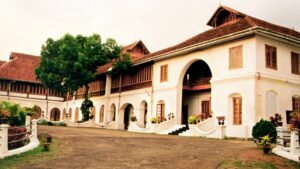
Hill Palace Museum was the official residence of the erstwhile rulers of Kochi. Built in 1865, it is now famous for being a full-fledged Ethno-Archaeological Museum and Kerala’s first-ever Heritage Museum.
Dr. Rajan stressed the importance of heritage conservation: “Heritage conservation does not mean only the conservation of monuments. Heritage exists in many forms — tangible, intangible, natural, etc. The important thing is to raise awareness among locals. Without inclusive participation, conservation is not possible.”
Dr Rajan explained that a culture policy could only be a long-term one. “The first thing we plan is to educate city councilors about the importance of heritage, because they are the representatives of the people. This cannot be achieved in a short-term period; yes, it is a long-term plan.”
Cochin Corporation Mayor Anilkumar said a heritage policy is a political project, since education in culture would alert citizens to the problems created by a devious manipulation of cultural symbols.
“Culture is a slippery zone. As a political figure, I hold the view that many of the challenges we face today stem from the manipulation of culture,” Mayor Anilkumar said.
“Kochi is cosmopolitan. Our city carries not only Dutch, Portuguese, and British influences but also the legacy of Travancore, Kochi, and Edappally kingdoms.” The city has historically accommodated Anglo-Indians, Jews, Marathis and Gujaratis, and has evolved as a cultural crossroad, the mayor explained.
He explained that the policy is geared towards striking the balance between tradition and progress. “We each have the right to live within our own culture,” Anilkumar said, explaining that the attempt was to ensure that Kochi’s heritage remains alive, even as the city negotiates challenges that did not exist previously.
(Edited by Rosamma Thomas)
